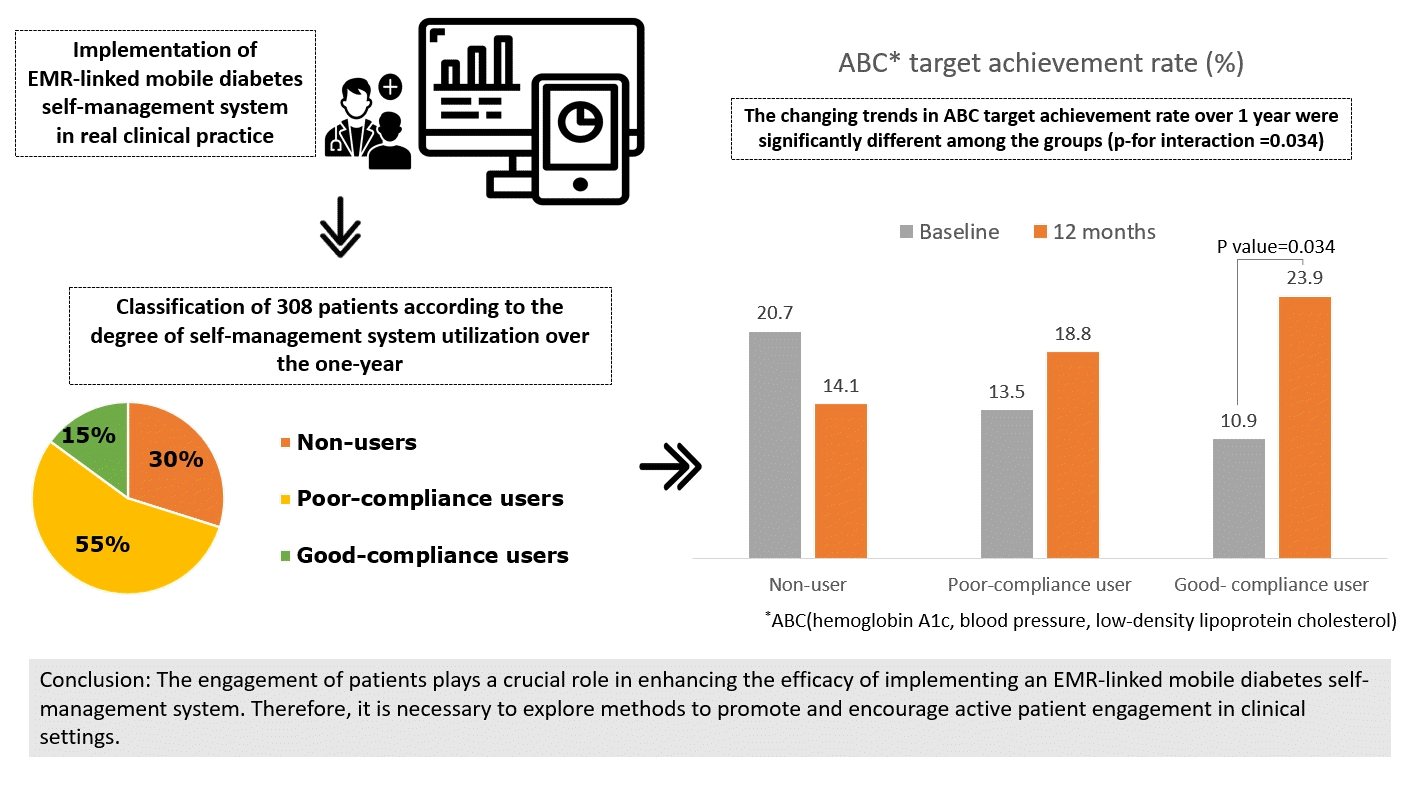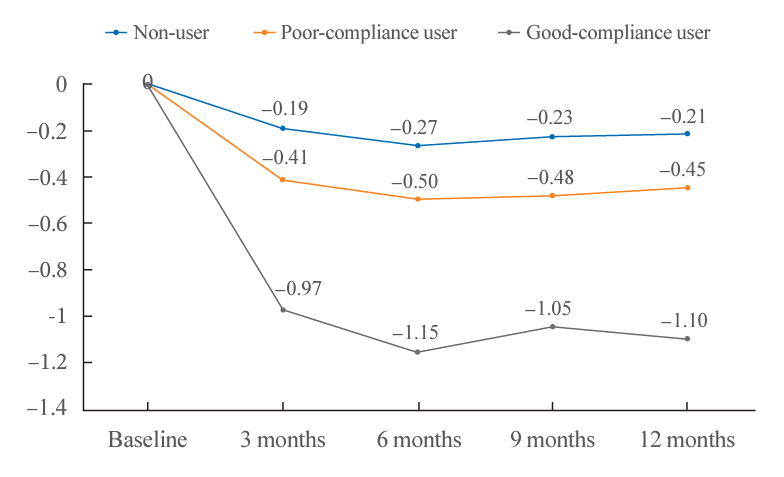INTRODUCTION
METHODS
Ethical considerations
Study population
EMR-liked diabetes self-management system (iCareD)
Clinical data collection
Group definition
Privacy protection
Statistical analysis
RESULTS
Baseline characteristics
Table 1.
| Characteristic | Total | Non-user | Poor-compliance users | Good-compliance users | P value |
|---|---|---|---|---|---|
| Number | 308 | 92 | 170 | 46 | |
| Male sex | 162 (52.6) | 48 (52.2) | 95 (55.9) | 19 (41.3) | 0.213a |
| Age, yr | 58.3±12.9 | 60.4±13.8 | 58.0±12.2 | 55.2±13.5 | 0.094b |
| Height, cm | 164.7±8.6 | 163.7±8.2 | 165.5±8.7 | 163.5±8.9 | 0.227b |
| Weight, kg | 66.0±12.2 | 64.7±11.5 | 66.7±12.2 | 66.0±13.7 | 0.359b |
| BMI, kg/m2 | 24.2±3.3 | 24.0±3.1 | 24.2±3.3 | 24.5±3.5 | 0.763b |
| DM diagnosed, yr | 14.5±10.3 | 16.6±10.6 | 13.8±10.1 | 12.8±9.5 | 0.057b |
| Type of DM | |||||
| Type 1 DM | 29 (9.4) | 7 (7.6) | 14 (8.2) | 8 (17.4) | 0.131a |
| Type 2 DM | 279 (90.6) | 85 (92.4) | 156 (91.8) | 38 (82.6) | |
| FBS, mg/dL | 153.7±58.3 | 147.5±54.0 | 154.5±58.3 | 162.8±66.3 | 0.664b |
| HbA1c, % | 7.9±1.6 | 7.7±1.8 | 7.8±1.4 | 8.3±1.7 | 0.063b |
| SBP, mm Hg | 122.6±13.8 | 121.4±13.5 | 124.0±14.4 | 119.5±12.0 | 0.091c |
| DBP, mm Hg | 75.2±10.9 | 73.6±10.6 | 76.1±11.3 | 75.0±9.8 | 0.215c |
| LDL-C, mg/dL | 85.9±31.0 | 81.6±29.4 | 87.4±32.8 | 89.2±26.4 | 0.084b |
| Glucose-modifying agents | - | ||||
| Metformin | 68 (73.9) | 126 (74.1) | 28 (60.9) | 0.185 | |
| DPP-4 inhibitors | 45 (48.9) | 102 (60.0) | 22 (47.8) | 0.132 | |
| SGLT2 inhibitors | 24 (26.1) | 27 (15.9) | 4 (8.7) | 0.026f | |
| Sulfonylureas | 27 (29.4) | 48 (28.2) | 13 (28.3) | 0.981 | |
| Alpha-glucosidase-inhibitors | 5 (5.4) | 3 (1.8) | 0 | 0.146d | |
| Thiazolidinediones | 9 (9.8) | 25 (14.7) | 3 (6.5) | 0.233 | |
| GLP-1 receptor agonists | 2 (2.2) | 2 (1.2) | 1 (2.2) | 0.559d | |
| Rapid/short-acting insulins | 23 (25.0) | 37 (21.8) | 15 (32.6) | 0.310 | |
| Basal insulins (intermediate/long-acting) | 12 (13.0) | 29 (17.1) | 16 (34.8) | 0.006g | |
| Blood pressure-modifying agents | - | ||||
| RAS blockerse | 33 (35.9) | 43 (25.3) | 13(28.3) | 0.196 | |
| Calcium channel blockers | 9 (9.8) | 10 (5.9) | 5 (10.9) | 0.372 | |
| Diuretics | 8 (8.7) | 7 (4.1) | 3 (6.5) | 0.314 | |
| Lipid-modifying agents | - | ||||
| Statins | 58 (63.0) | 93 (54.7) | 22 (47.8) | 0.201 | |
| Fibric acid derivatives | 2 (2.2) | 4 (2.4) | 1 (2.2) | 1.000d | |
| Ezetimibe | 5 (5.4) | 14 (8.2) | 6 (13.0) | 0.303 |
Values are expressed as mean±standard deviation or number (%).
BMI, body mass index; DM, diabetes mellitus; FBS, fasting blood sugar; HbA1c, hemoglobin A1c; SBP, systolic blood pressure; DBP, diastolic blood pressure; LDL, low-density lipoprotein cholesterol; DPP-4, dipeptidyl peptidase 4; SGLT2, sodium-glucose co-transport 2; GLP-1, glucagon-like peptide 1; RAS, renin-angiotensin system.
Changes in HbA1c levels according to the usage of the EMR-linked diabetes self-management system by time
Changes in 1-year ABC levels according to the usage of the EMR-linked diabetes self-management system
Table 2.
| Variable | Non-user | Poor-compliance user | Good-compliance user | Between P value (post hoc) | |
|---|---|---|---|---|---|
| HbA1c, % | |||||
| Pre | 7.7±1.8 | 7.8±1.4 | 8.3±1.7 | 0.063b | |
| Post | 7.5±1.3 | 7.4±1.1 | 7.2±0.9 | 0.352b | |
| Diff | −0.2±1.6 | −0.4±1.4 | −1.1±1.8a | 0.014b,e | |
| Within P value | 0.642c | <0.001c,f | <0.001c,f | ||
| Weight, kg | |||||
| Pre | 64.7±11.5 | 66.7±12.2 | 66.0±13.7 | 0.359b | |
| Post | 64.4±10.9 | 66.4±12.2 | 64.8±13.2 | 0.331b | |
| Diff | −0.3±3.5 | −0.3±2.5 | −1.2±2.7 | 0.062b | |
| Within P value | 0.194c | 0.251c | 0.001c,f | ||
| BMI, kg/m2 | |||||
| Pre | 24.0±3.1 | 24.2±3.3 | 24.5±3.5 | 0.763b | |
| Post | 23.9±2.9 | 24.1±3.2 | 24.1±3.2 | 0.984b | |
| Diff | −0.1±1.3 | −0.1±0.9 | −0.5±1.0 | 0.073b | |
| Within P value | 0.247c | 0.223c | 0.001c,f | ||
| SBP, mm Hg | |||||
| Pre | 121.4±13.5 | 124.0±14.4 | 119.5±12.0 | 0.091a | |
| Post | 122.1±13.8 | 123.0±14.1 | 119.6±13.9 | 0.342a | |
| Diff | 0.7±14.9 | −1.0±14.2 | 0.1±14.1 | 0.944b | |
| Within P value | 0.830c | 0.519c | 0.975d | ||
| DBP, mm Hg | |||||
| Pre | 73.6±10.6 | 76.1±11.3 | 75.0±9.8 | 0.215a | |
| Post | 13.8±11.0 | 74.1±11.1 | 72.7±11.9 | 0.736a | |
| Diff | 0.2±10.4 | −2.0±10.5 | −2.3±9.2 | 0.272b | |
| Within P value | 0.873d | 0.039c,e | 0.091d | ||
| LDL-C, mg/dL | |||||
| Pre | 81.6±29.4 | 87.4±32.8 | 89.2±26.4 | 0.084b | |
| Post | 81.5±25.5 | 79.3±24.3 | 79.4±23.4 | 0.787b | |
| Diff | −0.1±23.5 | −8.1±33.6 | −9.8±28.3a | 0.046b,e | |
| Within P value | 0.442c | 0.049c,e | 0.030c,e |
Values are expressed as mean±standard deviation.
ABC, HbA1c, blood pressure, and LDL-C; HbA1c, hemoglobin A1c; BMI, body mass index; SBP, systolic blood pressure; DBP, diastolic blood pressure; LDL-C, low-density lipoprotein cholesterol.
Changes in 1-year ABC target achievement rate (%) according to the usage of the EMR-linked diabetes self-management system
Table 3.
| Variable | Non-user | Poor-compliance user | Good-compliance user | Between P valueb | P value for interactionc | |
|---|---|---|---|---|---|---|
| HbA1c <7%, % | ||||||
| Pre | 33.7 | 27.7 | 26.1 | 0.519 | 0.118 | |
| Post | 34.8 | 39.4 | 47.8 | 0.335 | ||
| Within P valuea | 0.457 | 0.010d | 0.012d | |||
| BP <130/80 mm Hg, % | ||||||
| Pre | 56.5 | 52.4 | 54.4 | 0.810 | 0.207 | |
| Post | 51.1 | 60.0 | 63.0 | 0.279 | ||
| Within P valuea | 0.411 | 0.063 | 0.258 | |||
| LDL-C <100 mg/dL, % | ||||||
| Pre | 76.1 | 72.9 | 67.4 | 0.554 | 0.066 | |
| Post | 76.1 | 81.8 | 84.8 | 0.396 | ||
| Within P valuea | 1.000 | 0.029d | 0.011d | |||
| ABC target achievement rate, % | ||||||
| Pre | 20.7 | 13.5 | 10.9 | 0.207 | 0.034d | |
| Post | 14.1 | 18.8 | 23.9 | 0.354 | ||
| Within P valuea | 0.201 | 0.106 | 0.034d |




 PDF
PDF Citation
Citation Print
Print





 XML Download
XML Download